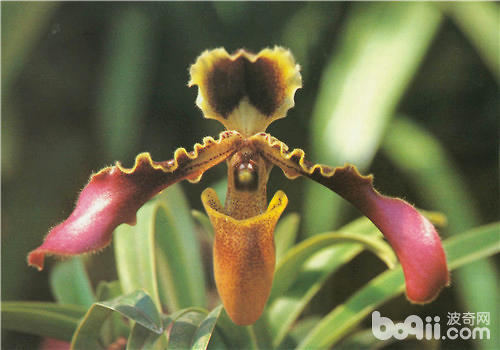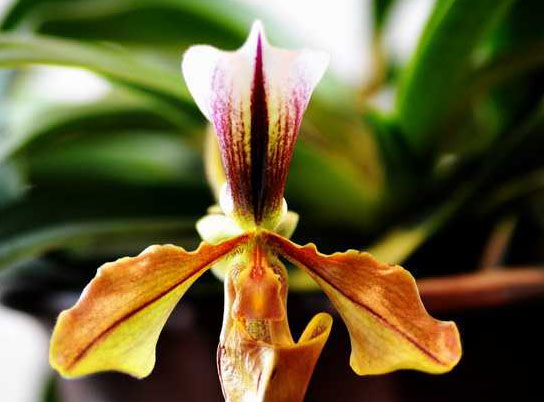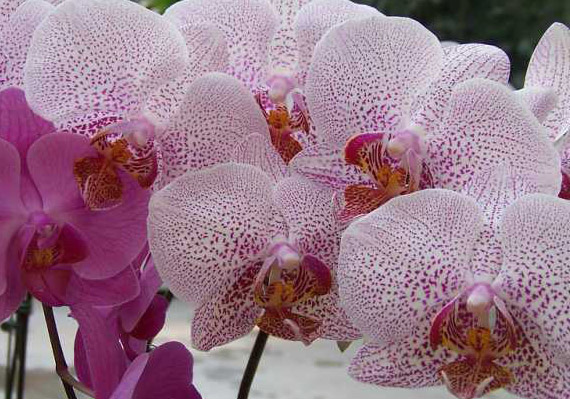What are the common cultivated varieties of Paphiopedilum
Dolan is known as slipper orchid. The flower shape is peculiar, each petal has stripes or spots, and the lip petals vary in the shape of a round pocket, similar to the front end of slippers, hence the name. Most of them are terrestrial orchids and a few are epiphytic orchids. Paphiopedilum is rich in color, has a long flower life, and has four seasons of flowering species. There are more than 10 species of Paphiopedilum made in China. The common cultivars are:
(1) Aristolochia mandshurica. A single flower, about 10 cm in diameter, rich in color, dark green and yellow, with purple spots or patterns on it, each flower can bloom for one month. Flowering in spring.
(2) Beautiful Paphiopedilum. Flowers are usually single, large, 13 cm in diameter. The pocket is large, yellowish green, with purplish red patches or markings. Each flower can bloom for 4 to 6 weeks. Flowering in winter and spring.
(3) Aristolochia lanceolata. The flower stem is stout, arched, 60 cm long, 4-6 flowers, petals linear, 10-12 cm long, yellowish green, with purple-brown markings. Flowering in summer.
(4) Aristolochia purpurea. Flowers single, large, yellowish purple, with purple-brown stripes. Flowering in winter and spring.
(5) Paphiopedilum hongkong. Flowers solitary, deep purplish red. Flowering in autumn and winter.
(6) Calyx Magnolia. The flower stem is erect and 50 cm long. Flowers solitary, purple-brown. There are several black verrucous spots inside and outside the petals, the labellum is deep pocket-shaped, and each flower can bloom for more than two months. The florescence is from March to May.
(7) Apricot Magnolia. Single flower, apricot yellow. The labial flap is an oval pocket. Flowering in spring.
(8) Paphiopedilum. There are 1-3 flowers on each flower stem, light yellow, the outside is covered with purple-brown spots, and the labellum is an ovate pocket. Each flower can bloom for 6-8 weeks. The florescence is from April to June.
(9) Purple Paphiopedilum. There are 1-2 flowers on each stem, and occasionally 3. The flowers are light yellow and covered with purplish red or brown spots on the outside. Each flower can bloom for 4 weeks. Flowering in spring and autumn.
(10) Aristolochia hardleaf. A single flower with a □ bag-shaped pocket on the lips, pink or nearly white, each flower can bloom for 2 to 3 weeks. The florescence is from February to March.

Aristolochia mandshurica
Paphiopedilum prefers warm, semi-overcast and humid environment. Like fertile, humus-rich, well-drained sandy soil. It is cultivated in shade in summer and well-lit in greenhouse in winter. In order to maintain high air humidity, water is sprayed on the plant and the surrounding ground every day. Rarefied liquid fertilizer can be applied after planting for more than 40 days, and the basin can be changed every 2-3 years. Adequate water supply is needed during the growing period, and watering should be controlled during the dormant period and the emergence of new buds.
The suitable temperature for the growth of Aristolochia mandshurica is 18 ℃ 25 ℃, and the suitable temperature for overwintering is about 12 ℃, which should not be lower than 5 ℃. If the temperature is 1 ℃, the leaves will wither and the plants will die. If the temperature is above 20 ℃ for a long time, the flower bud differentiation can not be carried out normally, it is difficult to blossom, and it is easy to rot. There should be proper shade in summer and plenty of light in winter. The cultivation substrate which is fertile and has good drainage and air permeability is required.
- Prev

What are the main points of daily maintenance of domestic Paphiopedilum?
Potted Paphiopedilum, such as terrestrial orchid, should choose rotten leaf soil, peat soil, moss, bark blocks and so on as planting materials, and the pot bottom should be covered with broken bricks and charcoal blocks accounting for about 1 inch of the flowerpot capacity, so as to facilitate drainage and ventilation. If it is an epiphytic orchid, moss and fern roots should be used as planting materials and should be soaked in water before use.
- Next

What should be paid attention to in daily maintenance of Phalaenopsis?
The butterfly orchid is large, white, with yellow-red labellum base and a pair of separate tendrils at the end. Sexual preference for warm, moist and semi-overcast environment. Potted Phalaenopsis should use porous and breathable plain roasting pots. The material should be loose, and the medium and small seedlings can be prepared with water moss and snake shavings. Adult plants should be prepared with semi-mixing of charcoal particles and snake chips.
Related
- Fuxing push coffee new agricultural production and marketing class: lack of small-scale processing plants
- Jujube rice field leisure farm deep ploughing Yilan for five years to create a space for organic food and play
- Nongyu Farm-A trial of organic papaya for brave women with advanced technology
- Four points for attention in the prevention and control of diseases and insect pests of edible fungi
- How to add nutrient solution to Edible Fungi
- Is there any good way to control edible fungus mites?
- Open Inoculation Technology of Edible Fungi
- Is there any clever way to use fertilizer for edible fungus in winter?
- What agents are used to kill the pathogens of edible fungi in the mushroom shed?
- Rapid drying of Edible Fungi

